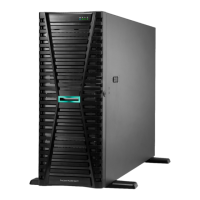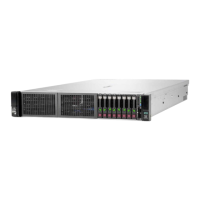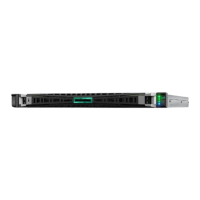3. Select Enabled or Disabled.
4. Save your changes.
Configuring Advanced Performance Tuning Options
Use Advanced Performance Tuning to control frequency changes that cause jitters and affect latency. You
can manage Jitter Control manually or automatically. You can also specify a frequency to use, regardless
of whether the processor frequency changes. For more information about Jitter Control, see HPE Gen10
Servers Intelligent System Tuning at https://www.hpe.com/support/gen10-intelligent-system-tuning-
en.
Procedure
1. From the System Utilities screen, select System Configuration > BIOS/Platform Configuration
(RBSU) > Power and Performance Options > Advanced Performance Tuning Options.
2. Configure settings.
• Processor Jitter Control—Manages processor frequency variance due to technologies, such as
Turbo, that varies the frequency based on power, thermals, and active cores. Jitter Control helps to
reduce or remove processor jitter and latency, and improve server performance. Select an option:
◦ Auto-tuned—Monitors frequency variance, and automatically adjusts the frequency to minimize
variance over time.
◦ Manual-tuned—Operates the processor at a fixed frequency, and enables you to select lower
or higher frequencies statically.
◦ Disabled—Disables Processor Jitter Control.
• Processor Jitter Control Frequency—Do one of the following:
◦ If you selected Auto-tuned, enter a starting frequency unit in MHz.
◦ If you selected Manual-tuned, enter a frequency unit in MHz.
NOTE: If your specified frequency is not supported, the system firmware adjusts the frequency to
the nearest higher intermediate frequency supported by the processor.
• Processor Jitter Control Optimization—When the auto-tuned function detects fluctuations in
processor frequency, this option optimizes the thresholds used. Select one of the following:
◦ Optimizing for Throughput allows only the amount of fluctuations that doesn't impact overall
compute throughput.
◦ Optimizing for Latency allows for a very small amount of occasional fluctuations to occur
before reducing processor frequency.
◦ Zero Latency attempts to eliminate any frequency fluctuations.
• Core Boosting—Use this feature to produce higher performance across more active processors.
Servers that include Core Boosting use extra server power and thermal headroom to reduce
common setbacks and maximize processor computing power.
98 Configuring Advanced Performance Tuning Options

